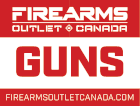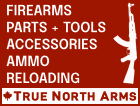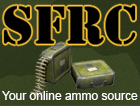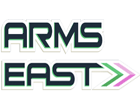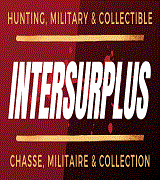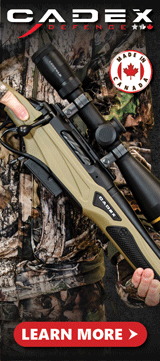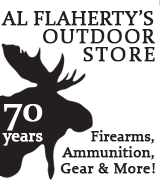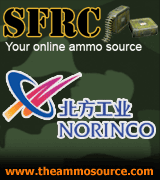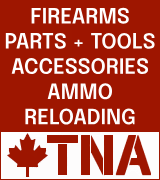You are using an out of date browser. It may not display this or other websites correctly.
You should upgrade or use an alternative browser.
You should upgrade or use an alternative browser.
AMMO Storage Question
- Thread starter nickia
- Start date
Yes you are even in the video we have for the RPAL which dates from the late 60 but that's still what they show you in the classroom the guy in the vid stores his ammo in the same locked cabinet so if someone tells you you cant show them this vid 4:30 to 6:00
http://www.youtube.com/watch?v=J1Bd48DWyxQ&list=FLC6BZ_Aom2A-V98QyL0ydDQ&index=1
The course videos were actually done in the mid-1990s.
After reading this entire thread I went through my reloading bench (located in my attached garage) and made sure there was no loose ammo to be found. My kids are much to small to ever play in there but I don't want to be negligent of even a single bullet. I have also been storing some bulk ammo in under a work bench completely out of sight and not easy to get at. I moved it to a locker that now has a lock on it. Basically I have changed my mind about this subject....
FitSoldier
New member
- Location
- Newmarket, ON
Sorry for reviving this thread. My shotgun has shotshell carriers attached. It is unloaded, trigger locked, and stored in a locked cabinet. Would I be okay if I had shotshells in the carriers? Or would I be hit with careless storage?
Last edited:
Trimmer 905
CGN Ultra frequent flyer
Sorry for reviving this thread. My shotgun has shotshell carriers attached. It is unloaded, trigger locked, and stored in a locked cabinet. Would I be okay if I had shotshells in the carriers? Or would I be hit with careless storage?
As long as the shotgun with the ammo in the sleeve is locked up together in a safe/locker,whatever,you're good. Firearms are NOT considered loaded unless there's shells in the magazine.
VanIsleCam
CGN Ultra frequent flyer
[/QUOTE
P.S. I keep my ammunition in large tool boxes with small locks. I believe this meets the definition of safe storage for the Firearms Act and Criminal Code. Its not ideal though since I am starting to amass more and more ammunition everyday.[/QUOTE]
This is what I do....
P.S. I keep my ammunition in large tool boxes with small locks. I believe this meets the definition of safe storage for the Firearms Act and Criminal Code. Its not ideal though since I am starting to amass more and more ammunition everyday.[/QUOTE]
This is what I do....
I'm sorry to resurrect this thread but I'm confused.
I am considering a safe from Canadian Safe Manufacturing and I called the Firearms line to get clarification on ammo storage. They told me that if I want to secure the ammo in my safe, where my firearms are also located I would need to have the ammo locked inside a case or box as well. So ammo locked in a box and the box locked in a safe. I didn't think this was correct but I also wasn't going to argue it either, they should know right?
So, can I store my ammo in my safe or does the ammo need to be locked in a separate case or box in order for it to be in the safe?
I am considering a safe from Canadian Safe Manufacturing and I called the Firearms line to get clarification on ammo storage. They told me that if I want to secure the ammo in my safe, where my firearms are also located I would need to have the ammo locked inside a case or box as well. So ammo locked in a box and the box locked in a safe. I didn't think this was correct but I also wasn't going to argue it either, they should know right?
So, can I store my ammo in my safe or does the ammo need to be locked in a separate case or box in order for it to be in the safe?
I'm sorry to resurrect this thread but I'm confused.
I am considering a safe from Canadian Safe Manufacturing and I called the Firearms line to get clarification on ammo storage. They told me that if I want to secure the ammo in my safe, where my firearms are also located I would need to have the ammo locked inside a case or box as well. So ammo locked in a box and the box locked in a safe. I didn't think this was correct but I also wasn't going to argue it either, they should know right?
So, can I store my ammo in my safe or does the ammo need to be locked in a separate case or box in order for it to be in the safe?
No they shouldn't know.
The firearms act is not the law on ammo, never has been never will be. You can store ammo and firearms in the same locked container.
NR
(c) it is not readily accessible to ammunition, unless the ammunition is stored, together with or separately from the firearm, in a container or receptacle that is kept securely locked and that is constructed so that it cannot readily be broken open or into.
R
(c) it is not readily accessible to ammunition, unless the ammunition is stored, together with or separately from the firearm, in
(i) a container or receptacle that is kept securely locked and that is constructed so that it cannot readily be broken open or into, or
(ii) a vault, safe or room that has been specifically constructed or modified for the secure storage of restricted firearms and that is kept securely locked.
http://laws-lois.justice.gc.ca/eng/regulations/SOR-98-209/page-1.html#h-3
http://laws-lois.justice.gc.ca/eng/regulations/SOR-98-209/page-1.html#h-4
Shawn
No they shouldn't know.
The firearms act is not the law on ammo, never has been never will be. You can store ammo and firearms in the same locked container.
NR
R
http://laws-lois.justice.gc.ca/eng/regulations/SOR-98-209/page-1.html#h-3
http://laws-lois.justice.gc.ca/eng/regulations/SOR-98-209/page-1.html#h-4
Shawn
Thank you Shawn, I'll read up on this.
Endangering others
Actually the only thing missing in the analysis is whether you live alone or not, with minor children being a special circumstance. A failure to secure ammunition from access by children would likely be considered careless. Likewise, you need to secure restricted/prohibited weapons from anyone who isn't the licensed owner.
It's reasonable to expect your children/partner won't take a crobar to a lock hasp, or pull the hinge pins on a locked door.
Actually the only thing missing in the analysis is whether you live alone or not, with minor children being a special circumstance. A failure to secure ammunition from access by children would likely be considered careless. Likewise, you need to secure restricted/prohibited weapons from anyone who isn't the licensed owner.
It's reasonable to expect your children/partner won't take a crobar to a lock hasp, or pull the hinge pins on a locked door.
Great... Now define "careless" and "reasonable" and we'll all know exactly where we stand.
I figure my house is just one big container. It even has a lock or two on it.
My ammo is kept on a shelf in the basement of that big brick container...
If you really want to know, See the below:
For your reference, you can find the Explosives Regulations online at: https://laws.justice.gc.ca/eng/regulations/SOR-2013-211/
The part you are interested in is Part 14 – see Sections 278 – 281 below.
Definition - small arms cartridge means a cartridge that is designed to be used in small arms, has a calibre of no more than 19.1 mm (.75 calibre), is fitted with centre or rim fire priming and contains a propelling charge, with or without a solid projectile. It includes a shotgun shell of any gauge. (cartouche pour armes de petit calibre)
Rules for Users
Acquisition
278 A user may acquire and store small arms cartridges, whether or not they hold a licence. A user who acquires small arms cartridges must comply with this Division.
Storage — licensed user
279 (1) A user who holds a licence must store their small arms cartridges in the magazine specified in their licence.
Storage — unlicensed user
(2) A user who does not hold a licence must store their small arms cartridges, including any small arms cartridges manufactured by the user under Division 2, in a dwelling or a storage unit and ensure that the requirements of sections 280 and 281 are met.
Maximum quantity
280 No more than 225 kg of small arms cartridges may be stored at any one time.
Note: In accordance with section 269, the reference to 225 kg of small arms cartridges is a reference to their net quantity (the mass of the explosive excluding the mass of any packaging, container, shell casing or projectile).
Storage requirements — dwelling
281 (1) When small arms cartridges are stored in a dwelling, they must be stored away from flammable substances and sources of ignition. People not authorized by the user must not be given unlimited access to the cartridges.
Storage requirements — storage unit
(2) When small arms cartridges are stored in a storage unit,
o (a) the storage unit must be located in a dry place, away from flammable substances and sources of ignition;
o (b) the storage unit must be constructed and maintained to prevent unauthorized access and to protect the contents from weather;
o (c) if the storage unit is a container, it must not impede exit in case of fire;
o (d) if the storage unit is not a container, all exits must be kept unobstructed;
o (e) any shelving in the storage unit must be made from a non-sparking material (for example, wood or painted metal);
o (f) nothing other than propellant powder, percussion caps or black powder cartouches may be stored with the small arms cartridges;
o (g) small arms cartridges, propellant powder, percussion caps and black powder cartouches must be stored separately from one another (for example, on different shelves or separated by a wooden barrier);
o (h) the storage unit must be attended when it is unlocked;
o (i) the storage unit must be kept clean, dry, organized and free of grit;
o (j) any spill, leakage or other contamination in the storage unit must be cleaned up immediately;
o (k) precautions that minimize the likelihood of fire in or near the storage unit must be taken; and
o (l) a sign that displays the words “Danger — Fire Hazard/Risque d’incendie” in letters at least 10 cm high and that prohibits smoking using letters, or a symbol, at least 10 cm high must be posted on the storage unit in a clearly visible location.
Feel free to ask me any questions about this section. I hope this helps. A licenced user can store more than 225kg’s if we allow the person a licence.
David Murdoch
Inspector of Explosives
LMS/ESSB/ERD
Pacific Region, Vancouver BC
Natural Resources Canada / Government of Canada
david.murdoch@canada.ca
For your reference, you can find the Explosives Regulations online at: https://laws.justice.gc.ca/eng/regulations/SOR-2013-211/
The part you are interested in is Part 14 – see Sections 278 – 281 below.
Definition - small arms cartridge means a cartridge that is designed to be used in small arms, has a calibre of no more than 19.1 mm (.75 calibre), is fitted with centre or rim fire priming and contains a propelling charge, with or without a solid projectile. It includes a shotgun shell of any gauge. (cartouche pour armes de petit calibre)
Rules for Users
Acquisition
278 A user may acquire and store small arms cartridges, whether or not they hold a licence. A user who acquires small arms cartridges must comply with this Division.
Storage — licensed user
279 (1) A user who holds a licence must store their small arms cartridges in the magazine specified in their licence.
Storage — unlicensed user
(2) A user who does not hold a licence must store their small arms cartridges, including any small arms cartridges manufactured by the user under Division 2, in a dwelling or a storage unit and ensure that the requirements of sections 280 and 281 are met.
Maximum quantity
280 No more than 225 kg of small arms cartridges may be stored at any one time.
Note: In accordance with section 269, the reference to 225 kg of small arms cartridges is a reference to their net quantity (the mass of the explosive excluding the mass of any packaging, container, shell casing or projectile).
Storage requirements — dwelling
281 (1) When small arms cartridges are stored in a dwelling, they must be stored away from flammable substances and sources of ignition. People not authorized by the user must not be given unlimited access to the cartridges.
Storage requirements — storage unit
(2) When small arms cartridges are stored in a storage unit,
o (a) the storage unit must be located in a dry place, away from flammable substances and sources of ignition;
o (b) the storage unit must be constructed and maintained to prevent unauthorized access and to protect the contents from weather;
o (c) if the storage unit is a container, it must not impede exit in case of fire;
o (d) if the storage unit is not a container, all exits must be kept unobstructed;
o (e) any shelving in the storage unit must be made from a non-sparking material (for example, wood or painted metal);
o (f) nothing other than propellant powder, percussion caps or black powder cartouches may be stored with the small arms cartridges;
o (g) small arms cartridges, propellant powder, percussion caps and black powder cartouches must be stored separately from one another (for example, on different shelves or separated by a wooden barrier);
o (h) the storage unit must be attended when it is unlocked;
o (i) the storage unit must be kept clean, dry, organized and free of grit;
o (j) any spill, leakage or other contamination in the storage unit must be cleaned up immediately;
o (k) precautions that minimize the likelihood of fire in or near the storage unit must be taken; and
o (l) a sign that displays the words “Danger — Fire Hazard/Risque d’incendie” in letters at least 10 cm high and that prohibits smoking using letters, or a symbol, at least 10 cm high must be posted on the storage unit in a clearly visible location.
Feel free to ask me any questions about this section. I hope this helps. A licenced user can store more than 225kg’s if we allow the person a licence.
David Murdoch
Inspector of Explosives
LMS/ESSB/ERD
Pacific Region, Vancouver BC
Natural Resources Canada / Government of Canada
david.murdoch@canada.ca

